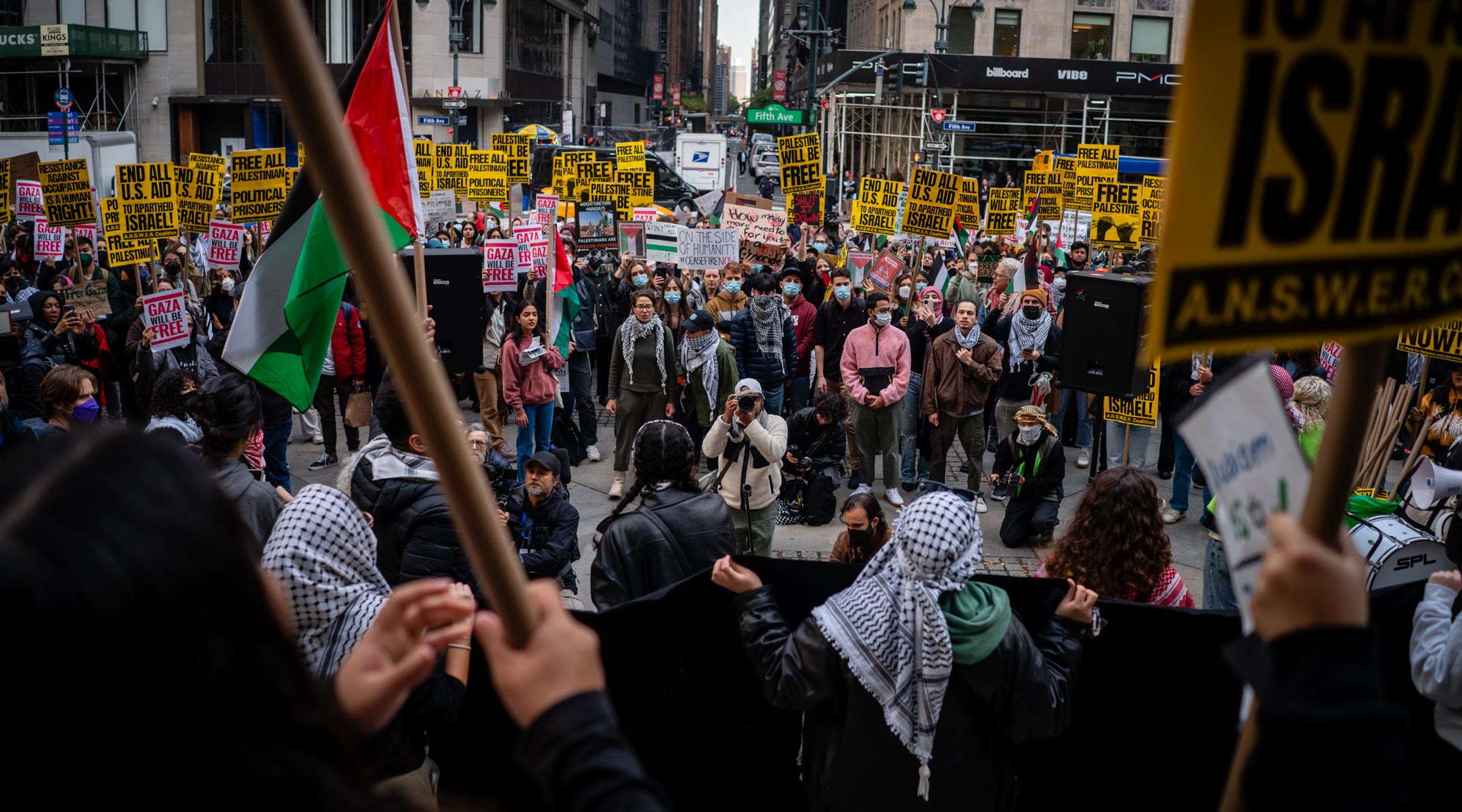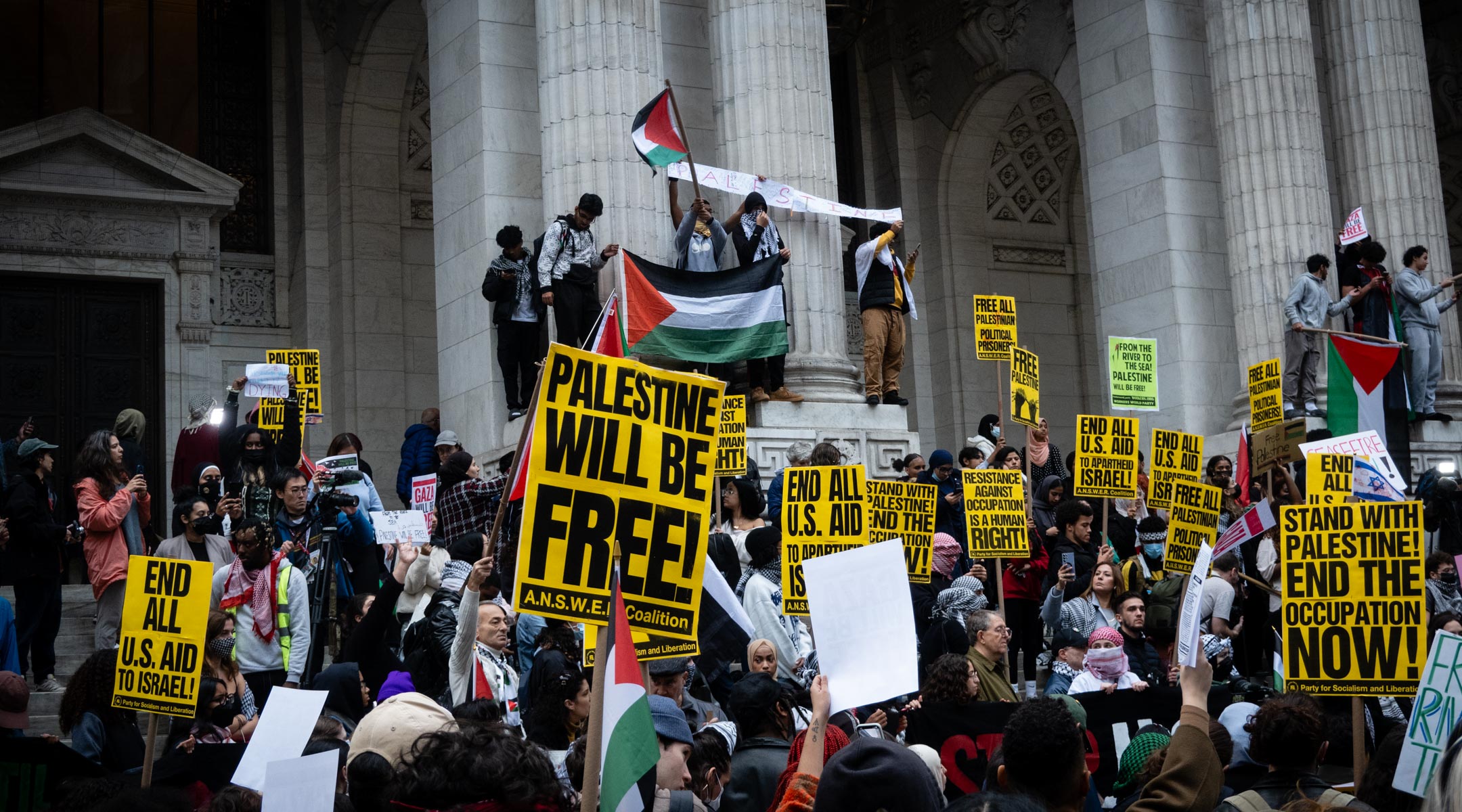(New York Jewish Week) – Hundreds of high school students and adults gathered near Bryant Park, heeding the call of a coalition of pro-Palestinian groups for New York City high school students to stage a walkout in protest of Israel’s war with Hamas in Gaza.
The crowd chanted “Intifada,” called for a ceasefire, accused Israel of genocide and praised Palestinian “resistance.” Actress Susan Sarandon, a longtime critic of Israel, made an unannounced appearance.
Organizers had released a detailed guide to help students schedule, recruit for, organize and gain administrator consent for the walkout, but the majority of the crowd appeared to be older than school age. One speaker told the audience that “over 150” students had walked out of class, out of the hundreds of thousands of high schoolers in the city. Some young people joined the event later in the day, after schools let out.
The crowd chanted, “From the river to the sea,” “Israel is a racist state,” and “There is only one solution, intifada revolution,” from the steps of the New York Public Library. Attendees carried signs that said, “Resistance against occupation is a human right,” and “Free all Palestinian political prisoners.”
Activists posted stickers around the protest saying, “Stop the Holocaust in Gaza” and warning “Zionist donors” against interfering in colleges.
The war began on Oct. 7 when Hamas invaded Israel, killing 1,400 and taking more than 200 people hostage. Israel has since conducted heavy airstrikes in Gaza and launched a ground invasion with the aim of deposing the terror group. According to the Hamas-run Health Ministry in Gaza, more than 10,000 people have been killed, though it isn’t clear how many are civilians and how many were killed by misfired Palestinian rockets.
Sarandon told the crowd, “So many people do not understand the context in which this Oct. 7 assault happened. They don’t understand the history of what has been happening to the Palestinian people.”
She added, “It’s time to have an open heart. It’s time to be strong and it’s time that Palestine be free.”
Speakers at the rally decried civilian fatalities in Gaza and framed the war as the focal point of a global struggle against profit-seeking Western imperialism, raising the topics of U.S. labor unions, homelessness in New York City, U.S. taxes and the policies of New York investment firms.
“The situation in Gaza today is unfathomable,” a speaker from the Palestinian Youth Movement, one of the organizers, told the crowd. “Every day we hear from our people in Gaza, ‘Today was the worst day so far.’
“From the river to the sea, the struggle for Palestinian liberation only grows stronger and stronger in the face of the bombs and bullets of the oppressive Zionist and imperialist world,” said the speaker, who did not share her name. “The expansionist genocidal nature of the Zionist settler colony could not be more blatant.”
A high schooler told the crowd, “We are showing the people of Gaza that they are being listened to.”
“We are the resistance fighters of the West,” the student said. “And we will not be quiet until Palestine is free.”
The groups organizing the protest demanded an immediate ceasefire and “an end to U.S. support for genocide” in materials addressed to students, teachers and parents released ahead of the rally.

Pro-Palestinian protesters near Bryant Park in New York City, November 9, 2023. (Luke Tress)
The event, called a “Day of Action,” was sponsored by a number of pro-Palestinian and educators’ groups, including the Palestinian Youth Movement, Teachers Unite and the Movement of Rank and File Educators, the progressive caucus within the city teachers union.
The Community Education Council in District 14 in Brooklyn, an elected entity that is part of the city’s school governance structure, also signed onto the rally. The council and several other organizers did not respond to requests for comment.
The group’s “toolkit” included a guide for calling members of Congress, plans for the student walkout, instructions for educators, drafts for parent-teacher association anti-Israel resolutions, and talking points echoing the messages delivered at the rally.
The toolkit suggested educators support student protesters by canceling tests or deadlines, and that students should protest inside school buildings if they are not comfortable leaving campus.
Educational materials from organizers appeared to justify the Oct. 7 attacks, saying, “Palestinians tore down the cement walls caging them in the Gaza Strip.”
The talking points included the claim that Israel had killed 900 people in a hospital bombing last month, which has been debunked by a wide range of assessments by intelligence agencies and publications, and that it was deliberately killing civilians who were fleeing the fighting, which Israel strenuously denies. Israel has opened up protected corridors for civilians to evacuate and has instituted humanitarian pauses to provide for civilian needs.
Chancellor David Banks on Wednesday warned educators against bringing politics into the classroom. In an email the Department of Education shared with the New York Jewish Week, he said he had planned to send that message before the announcement of the walkout.
“School leaders, teachers, and other school staff should not express their personal views about political matters during the school day,” the email said. “Our job as educators is to expose our students to objective facts and multiple perspectives, allowing them to make their own judgments and grow as independent and critical thinkers.”
Late last month, Banks expressed alarm about “hateful rhetoric at educational institutions” surrounding the war. Days after the Hamas attack, Banks condemned the “horrific acts of violence” and said the school system would provide resources to facilitate discussion about the conflict.
New York City Department of Education regulations stipulate that “School buildings are not public forums for purposes of community or political expression.” Regulations also say that employees cannot engage in political activities during working hours.
School protests against gun violence in recent years, particularly following the 2018 school shooting in Parkland, Florida, offered a recent precedent for staging protests at schools. Any disciplinary measures for illegal activity would need to be consistent, and past disciplinary measures have been moderate, said David Bloomfield, a professor of education, leadership, law and policy at Brooklyn College and the CUNY Graduate Center.
“If the school administration didn’t punish teachers for participating in the anti-gun violence rallies, it can’t turn around and be more stringent against a pro-Palestinian demonstration,” he said.
Bloomfield said it was legal for educators to encourage the day of action, but some of its activities may not be legal during work hours. Students and faculty, he said, “need to be careful that their speech doesn’t drift into hate or threats of violence.” The participation of the Community Education Council was also legal, he said.
Faculty needed to focus on keeping students safe during the walkout, he said, adding that teachers who actively protested during school hours may be subject to disciplinary measures. It wasn’t clear if any public school educators participated in the protest.
Rabbi Yossi Schwartz, the director of the Orthodox Union’s Jewish Student Union in New York, a youth group, said the organization has been grappling with antisemitism in high schools since Oct. 7. The group runs clubs meant to bolster Jewish identity and connections to Israel in around 30 public schools in New York City and Long Island, along with one location in Westchester.
“I think the world out there knew that it was going on in colleges but the fact that it’s even in high schools, I think is shocking,” Schwartz said, adding that the group had tallied five antisemitic incidents in New York City public schools in the past week.
The New York Jewish Week brings you the stories behind the headlines, keeping you connected to Jewish life in New York. Help sustain the reporting you trust by donating today.





